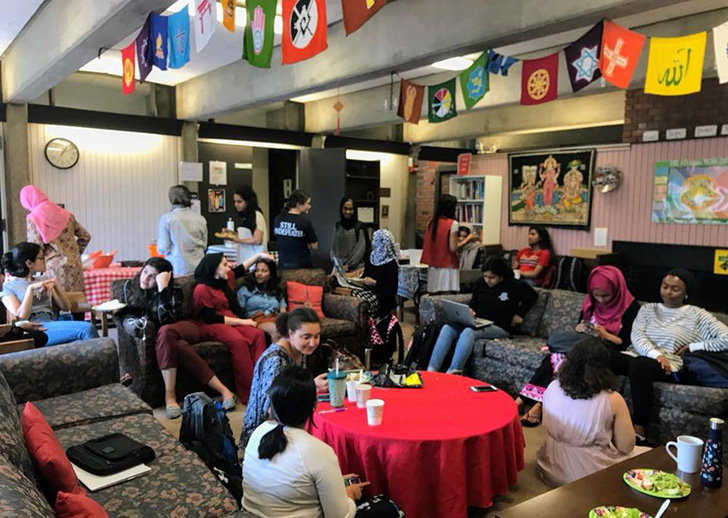Interfaith Learning May Be on the Line—And Matters More Than Ever
In a time of heightened polarization and discord—when those of different religious and political persuasions find reason to disagree on everything from the efficacy of masks in a global pandemic to the results of a contentious presidential election—pathways to cooperation seem elusive. Higher education has long been touted as a promising intervention for reducing prejudice and building bridges between people of different social identities and worldviews. Indeed, campuses today are rife with curricular, co-curricular, and social opportunities that hold great potential when it comes to disrupting the boundaries that divide us and inspiring newfound appreciation for others. With recent threats to diversity, equity, and inclusion (DEI) programming, some of these efforts may be on the line. Also troubling in this time of economic instability are measures taken by higher education institutions to conserve resources by consolidating programs or eliminating them altogether—including programs in religion that may be key to a more just and cooperative future.
As one of the lead researchers on a five-year national study of college students’ engagements with religious diversity, the Interfaith Diversity Experiences and Attitudes Longitudinal Survey (IDEALS), I have been struck time and again by the important role that college plays in dismantling students’ stereotypes and provoking changes in their attitudes and behaviors. A partnership among researchers and practitioners at NC State University, Ohio State University, and Interfaith Youth Core, IDEALS tracked the interfaith learning and development of first-term students at 122 colleges and universities across the country from their first semester on campus (Fall 2015), to the end of their first year (Spring/Fall 2016), and to the end of their fourth year (Spring 2019). Case studies at 18 of the IDEALS campuses offered deeper insight into the hows and whys of students’ growth and change. Among the stand-out findings of IDEALS are the dramatic and positive changes in attitudes toward different religious and nonreligious identity groups that students undergo (particularly in the first year on campus), the power of interfaith friendships in fostering intergroup appreciation, and the urgent challenges that remain when it comes to ensuring that campuses are welcoming and inclusive.
Evidence from IDEALS also suggests that threats to DEI programming and curricular programs focused on religion are concerning in light of gaps in students’ religious literacy and their tepid motivation to address those gaps. IDEALS assesses students’ religious literacy via a brief eight-item quiz that illuminates not only whether students possess knowledge of various worldviews—but whether the knowledge they have casts the religious tradition or worldview in a positive light. On the whole, students made notable gains in appreciative knowledge across the college years. Whereas entering first-year students averaged a score of 4.74 (out of 8) on the religious literacy quiz, scores increased to an average of 5.06 by the end of the first year and to an average of 5.35 by the end of the fourth year. Even so, as we revealed in our latest national report, nearly three-quarters of students (72%) neared the end of college averaging only a “C” (6 out of 8 questions correct) on the religious literacy quiz. And their drive to grow more knowledgeable was lukewarm at best. When asked about the time they devoted to learning about religious diversity, we found that less than half of college students said they had devoted time to learning about people of seven specific worldview identities (e.g., atheists, Buddhists, Evangelical Christians, Muslims).
While evidence about whether students devote time to learning about specific religious and worldview groups is less than encouraging, they do appear to have a general interest in engaging religious diversity in various ways. In fact, the longer students were in college, the more they made an effort to seek out academic learning opportunities to bolster their knowledge of interfaith dynamics, religion, and spirituality. At the end of their first year on campus, just a quarter (26%) of IDEALS participants reported “high” (14–19 activities) or “moderate” (6–13 activities) levels of curricular religious or spiritual engagement. This number grew by a factor of 16 percentage points (to 42%) by the time students were seniors. Students’ curricular engagement, though, depends on context, with course-taking patterns varying quite a bit by institutional characteristics. The unevenness in students’ course-taking across different types of colleges and universities resulted in those attending religious institutions having more exposure to religious, spiritual, and interfaith curricular initiatives. It’s also important to point out that although out-of-class interfaith activities drew a relatively small number of college students, a significant number of students engaged religiously diverse peers in social settings—a trend that began prior to college and persisted through the senior year. In the end, based on their curricular decision-making as they progress through college, students appear to want more opportunities to invest in academic learning about religious diversity—and they need occasions for in-depth learning that centralizes the narratives of distinctive traditions. On the co-curricular front, few students are taking the time to invest in DEI activities with an interfaith focus, which may limit their ability to cultivate the skillset they need to productively navigate their (frequent) engagement with religiously diverse peers.
Coupled with threats to DEI programming and reduced resources in higher education to prioritize programs in religion, we are at a crossroads. To meet student needs—as well as their budding demand—for interfaith learning, as educators and practitioners the time is now to bolster our arguments to protect the academic and co-curricular initiatives that will improve learning—and, by extension, may hold the key to a less polarized, more cooperative society.
Image: Jummah lunch at Mount Holyoke College, 2018. Facebook.




